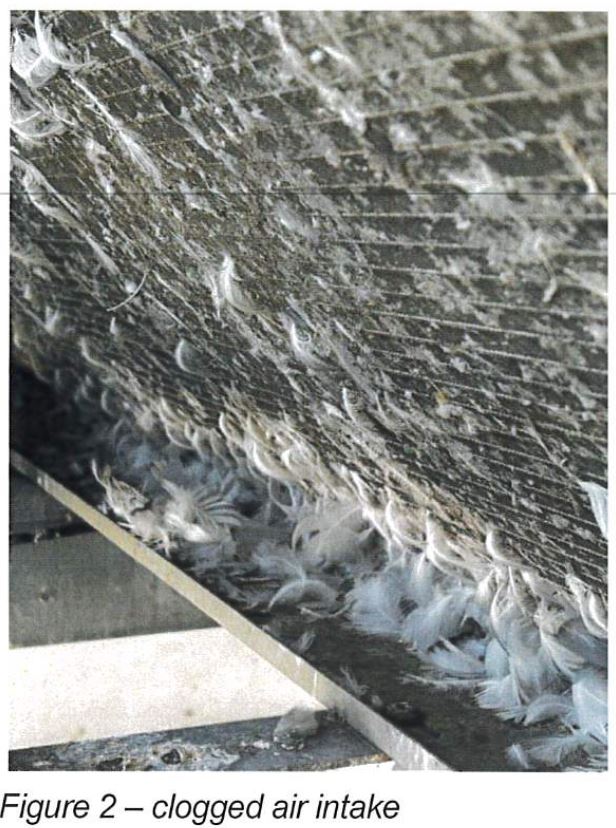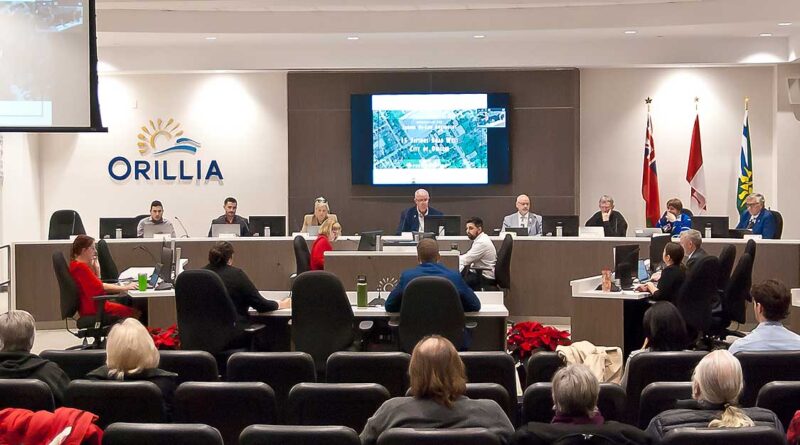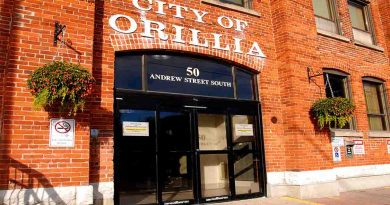Council Preview
By John Swartz
Orillia council meets Monday, October 21, at 2 p.m. It has a lengthy agenda to wade through.
The item of most interest is a report from the engineering department which, if council goes along with it, will authorize Mayor Don McIsaac to contract with the Town of Newmarket for automated speed enforcement (cameras).
It’s difficult to find a news story or study that reflects positively about benefits of speed cameras; even so it also depends on whether such stories reflect the viewpoint of police and municipal spokespersons, or are independent examinations of their effectiveness. Over and over again the words cash cow and cash grab are used.
What is clear is where cameras are installed and how the cameras are calibrated to detect speed and trigger a ticket (i.e. the tolerance, or forgiveness for not driving at the speed limit) is important.
Location-wise it makes a difference if they are installed to monitor traffic at the beginning of a zone where speed limitslower, the middle, or near the end of the zone. Poorly located cameras which are installed at the beginning of speed limit changes produce more tickets than the other two locations. This would be a clear indication the motivation for installing the cameras is for revenue and not safety.
Staff say the camera software can be set to only trigger a ticket depending on how many kilometers over a vehicle is travelling, from as low as zero over to whatever higher number is desired.
In the U.S. ticket revenue is used to fund police departments, creating a conflict of interest with using the cameras. Here, this is not the case and staff say revenue is, “recommended to be reinvested into program costs or road safety improvement initiatives,” which council could use to repair potholed and crumbling patches of roadway on Canice, Neywash, Nottawasaga, and Fittons (just in the North end; there are many other patches City-wide one could think of that require some attention). Technically the OPP budget is a program.
The motion also authorizes $285K from the capital tax levy reserve be used to pay for leasing, not buying, cameras and installation, which staff expects to recover from fines; “… these cameras are expected to generate enough revenue to cover both installation and leasing expenses.”
Staff say the cameras would be used only in Community Safety Zones. At last November’s budget meetings council created 7 additional zones near schools, and in another report for Monday’s meeting will likely add another on Atlantis Drive.
Staff also say the cameras can be programmed to only function at certain times, rather than all day. Logically they would only operate corresponding to the time periods lower speed limits are in effect in community safety zones, which are before school starts and when students are going home. Anything other than that would clearly be for revenue generation rather than safety.
Previous reports on this issue showed the penalty would be $3 per km for the first 19 km over and increasing incrementally beyond. Staff now say the penalty would be $6 per Km. Tickets being issued in a community safety zone are doubled, so the fine would be $12 per km.
Back To The Beginning
Council’s day starts with two deputations. The first is by Sandra Lee who is the manager of strategic partnerships, business intelligence and system planning for the County of Simcoe. She will be informing council of the launch of the Local Immigration Partnership.
According to County stats there are 82K immigrants in the County, which amounts 15% of the total population. Orillia’s immigrant population increased by 14% between 2016 and 2021 to 3,115 people.
Municipalities joining the county program will get help planning service delivery and integrating immigrants into the community.
Next, Kyla Epstein and Linda Reid of Green Haven Shelter for Women will be asking for funding. They say 12 of the 13 beds in the facility are not funded by the province and they are asking the City fund one of the remaining beds for one year. They are asking the same of the County.
It costs $71, 500 per bed to operate and so far in 2024 they have had to turn away 300 women because there was no room for them. They have also laid off 3 staff members. They are working on a plan for funding in 2025.
Next is the public forum and then a closed session. In closed session council has 4 items. One is about legalities regarding the Lake Simcoe Region Conservation Authority. Two are land proposals, a sale in the Horne Business Park and a property the City is interested in buying. The CAO, Gayle Jackson, has a report about a staffing matter.
Reports
In March Jason Kerr, a teacher at Harriet Toss Public School, wrote on behalf of a group to have 4 raised garden beds installed in Lakeview Park (near the school), which students would use. They have raised the funds to make the beds.
Staff said until the parks, recreation and culture master plan study is done, they want permission to report back to council about amending City policy on community gardens to identify the maximum number and locations for the gardens before they will address this request. They expect to have the study done in 2026, so in the meantime they want council to receive the report, which means do nothing for now.
Next, development services and engineering has a report of the City’s goose management efforts. This report focuses on waterfront parks. Unlike Kitchener Park where a barrier of wildflowers planted along the shore of Lake Simcoe by Bob Bowles has been effective keeping geese out of the park, the geography of the beach and the port aren’t good for that. Staff say most nesting happens on the break wall and that removing eggs and nests has been the most effective method of reducing geese in the parks.
They also have a o program to drive the geese off land a few times a week, and use lasers in the marina for control.
Staff say the egg and nest method has resulted in the reduction of nests from 250 in 2017 to less than 50 this year. Wildlife experts say without that measure the number of nests would likely have increased by 185 and added 1,290 goslings to the population. It costs the City $25,000 to $30,000 annually to deal with the geese.

Keeping with the bird theme, staff also have a report regarding seagulls and the Orillia Public Library roof. Planting shrubs on the seawall at the Port proved effective for seagulls (but not geese) on the waterfront, but they simply moved to rooftops in the downtown.
The seagulls are damaging the HVAC system and cooling lines. Staff also refer to increases in pigeon and cormorant populations elsewhere in the City in the report.
The would like council to refer a budget request to the 2025 budget committee (meetings in November) in the amount of $168K to hire a contractor to solve the problem, and another $20K to the bird program in general. The City already spends $30K annually on its bird program.
Stop It
Council has a report from engineering following from an enquiry motion to change temporary all way stops at Brant and Canice Streets, and to change stops to all way at Peter and Borland and Peter and Jarvis.
It’s is important to note that traffic on Peter and Canice Streets has increased because of construction on Laclie, so the study staff did naturally showed increased traffic, which presumably would decline once Laclie is finished.
Of the three criteria the province has set for all way stops, the amount of traffic was the only one meeting the threshold. However the volume of traffic on the cross streets was not high enough, nor more than a 70/30 split to qualify, so staff is recommending council receive the report, which means do nothing.
Nice Asset You’ve Got There
Engineering has a request of council to “establish proposed levels of service targets and create an associated financial strategy referencing the 2025-2034 10-Year capital and reserve forecast, based on data available as of December 31, 2024.”
The City has been dealing with a requirement of the province for municipalities to create asset management plans by July 1, 2025. Grant funding from the province can be affected for those which do not have plans by then.
There have been many reports to council and the idea for a 10-year capital plan is an offshoot of investigating asset management.
Asset management has been the rage for government and publicly funded entities for about 15 years. It shifts the emphasis from financial planning for capital expenses from a wants, desires and unforeseen circumstances perspective to a more practical approach of investigating when is this thing likely going to kick the bucket rather than waiting of something to obviously need repair or replacement as it pertains to all City assets.
It has sent accountants off on missions to gather data on life spans of vehicles, to building components, to pipes in the ground and roads. It’s an exercise in determining experience from promises of performance. This helps greatly to plan for timing expenditures for major items like Laclie Street reconstruction (and if asset management been a thing in the 90s it may have indicated Laclie Street should have been reconstructed a decade or two ago).
The problem is there are some things council has set different direction related to some assets (mostly levels of service delivery different from council priority and provincial requirements). Staff say this can be done but requires more work to justify not including them in the provincial direction and they would not meet the July 1 deadline.
In general terms, having an asset management perspective and a maintenance and replacement plan in place is the difference between your lawn mower suddenly not working and having to spend money on it now, rather than knowing experience with lawn mowers of your quality and vintage says you should have planned to buy one last year and having to rejig your budget now to do so.
Getting Our Housing In Order
Engineering has a report outlining an implementation plan for the housing attainable supply action plan.
Council previously embarked on investigation of our housing needs, funding and directives from other levels of government. The County has also done significant work and has a plan. Staff recommend the City align with the county.
One of the recommendations is council focus on development of housing which results in prices in the $215k to $310K for ownership and $1,100 to $1,600 rental ranges, which many would say is still too high.
Staff want council to approve in principal a plan which has short, medium and long-term goals. Those goals include changing Official Plans and zoning bylaws to permit better financing for development and renovations, and utilizing more publicly owned land (which for many municipalities, like Orillia, includes mostly park land).
Increasing The Debt
A few years ago council changed its policy regarding debt. The treasurer of the day said Orillia had the ability to carry some debt within provincial limits and relative to what other communities carry. Council then approved borrowing for street lighting, the Centennial Drive project and the first phase of the Laclie Street project totalling $22 million.
The report council has is asking for approval to formally increase the debt to $41 million for phase 2 of Laclie and renovating Brian Orser Arena (both projects are under way, and council previously endorsed debt financing for those projects).
The province regulates according to total payment amounts of no more than 25% of revenue, which means the City could technically borrow a lot more than it plans to this point since repayments would be $4.1 million, while the regulated capacity is $23.6 million.
Interestingly, the Laclie Street project was originally conceived as a 3 phase project, which got changed to 4 phases over 4 successive years; this report says now phase 3 (originally scheduled for 2025) won’t start until 2027 and the fourth phase in 2028, which is good news to those who regularly use that vehicle suspension destroying part of Laclie. The cost of the next two phases is $20 million of which staff estimate $16 million will be added to the City’s debt total.
Motions
Counicllor Tim Lauer has a notice of motion (which means the actual motion will come at the next meeting) to change from the ward system for elections to at large. Details of the reasoning will presumably be in a report at the next meeting.
Mayor McIsaac and councillor Janet-Lynne Durnford have an motion to reconsider a resolution regarding “fees for problematic properties requiring repetitive police attendance.”
The reason for reconsidering is to change the by-law council adopted to charge property owners a fee when police have attended more than once for criminal activity. The problem is it is word in a such a way, landlords argue, there is no incentive to rent to people with mental health issues, which is not what council intended.
The fee would also change to not kick in until a third occurrence because landlords say it penalizes them even if they have already started eviction proceedings, which can take months, prior to any police involvement. The report argues council did not intend to go after landlords who are taking action already. The fee per occurrence would be $500.
There are three enquiry motions. Counicllor Durnford has one to amend City policy to provide, “discounted rental fees and/or grant free use of the council chamber to educational institutions.” Presumably this would eliminate the need for users to go to council for special dispensation as occurred last meeting when Lake University asked for fees to be waived for a course.
Councillor Jay Fallis has an enquiry to exempt the first four dwelling units from the parkland dedication fee. Enquiries typically do come with supporting documentation in the council package, so the reasoning will not be known until today’s meeting.
Last, councillors Fallis, Durnford, Lauer and Jeff Czetwerzuk have an enquiry to report on the “feasibility and costs of introducing temporary vegetative features/installations in the Business Improvement Area that could be sponsored by individuals and/or businesses.”
Council meetings are open to the public or can be watched on the City’s Youtube channel.
(Photos by Swartz – SUNonline/Orillia; Images Supplied)




